Long-Term Water Absorption of Hybrid Flax Fibre-Reinforced Epoxy Composites with Graphene and Its Influence on Mechanical Properties
Abstract
:1. Introduction
2. Experimental Program
2.1. Materials
2.2. Specimen Fabrication
2.3. Water Absorption Test
2.4. Mechanical Testing
2.5. SEM Observations
3. Results and Discussion
3.1. Dynamic Mechanical Analysis (DMA)
3.2. Moisture Absorption Behaviour of Hybrid Flax Fibre Composites
3.3. Flexural Behaviour of Hybrid Flax Fibre Composites
3.3.1. Effect on Flexural Strength
3.3.2. Effect on Flexural Modulus
3.4. ILSS Behaviour of Hybrid Flax Fibre Composites
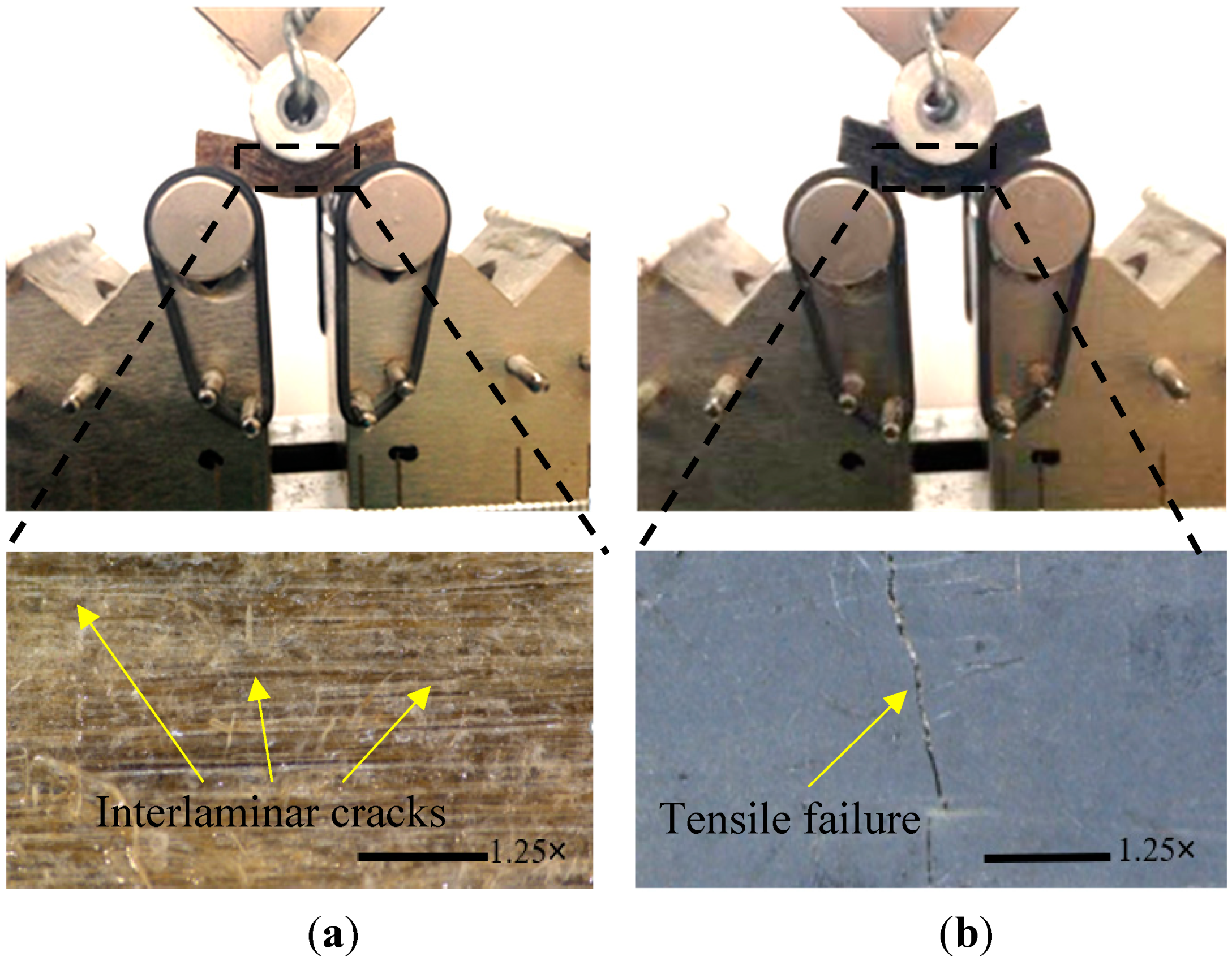
3.5. SEM Image Observations and Analysis


4. Conclusions
- The addition of graphene nanoparticles decreased the moisture absorption and moisture diffusion coefficient of flax-fibre-reinforced epoxy composites due to the graphene providing a barrier and a tortuous path to the matrix. Hybrid composites with 1.5% graphene exhibited the lowest moisture absorption rates and diffusion coefficients, which were 73%, 72%, and 71% and 71%, 49% and 26% lower, respectively, for 1000, 2000 and 3000 h than the ones without graphene.
- Graphene nanoparticles have a beneficial effect on the flexural and inter-laminar properties of flax fibre epoxy composites under wet conditions. This effect is mainly due to the improvement in the interfacial adhesion of the flax fibre to the epoxy matrix, and the increase in the stiffness and strength of the epoxy matrix is due to the addition of high-stiffness graphene.
- The moisture absorption affected FS and ILSS regardless of the graphene weight ratio, where a continuous decreasing trend was observed with increasing exposure durations. This is due to the matrix properties governing these two properties at room temperature.
- Longer-exposure duration deteriorates the interface of the hybrid composites more than shorter exposure times due to the increased ingress of water affecting its mechanical strength. Immersing the specimen with 0.5% graphene in water for 3000 h showed 10.7% and 7.3% higher reduction in flexural and ILSS strength, respectively, as compared to the same sample immersed in water for 1000 h.
- Regardless of the graphene weight ratio, the flexural modulus is the most significantly affected mechanical property by moisture absorption as this property is governed by fibre properties. Increasing the immersion time increased the water absorbed by the flax fibres and further reduced the flexural modulus as the absorbed water caused continuous deterioration of the flax fibre.
- Wet conditioning changed the failure behaviour of hybrid flax fibre composites. The laminates without graphene failed due to weak interfacial adhesion between the fibre and the matrix as evidenced by the crack propagation behaviour along the interface, whereas the hybrid composites with graphene failed by the flexural crack showing strong bonding strength at the interface. Under ILSS, the composites without graphene failed in inter-laminar shear mode originating either from the middle or ends of the samples, but those with graphene showed flexural failure due to the stronger fibre/matrix interface.
Author Contributions
Funding
Institutional Review Board Statement
Informed Consent Statement
Data Availability Statement
Acknowledgments
Conflicts of Interest
References
- Al Faruque, M.A.; Salauddin, M.; Raihan, M.M.; Chowdhury, I.Z.; Ahmed, F.; Shimo, S.S. Bast fiber reinforced green polymer composites: A review on their classification, properties, and applications. J. Nat. Fibers 2021, 1–16. [Google Scholar] [CrossRef]
- Kumar, S.; Manna, A.; Dang, R. A review on applications of natural Fiber-Reinforced composites (NFRCs). Mater. Today Proc. 2021, 50, 1632–1636. [Google Scholar] [CrossRef]
- Sanjay, M.; Arpitha, G.; Naik, L.L.; Gopalakrishna, K.; Yogesha, B. Applications of natural fibers and its composites: An overview. Nat. Resour. 2016, 7, 108–114. [Google Scholar] [CrossRef]
- Gurukarthik Babu, B.; Winston, D.P.; SenthamaraiKannan, P.; Saravanakumar, S.; Sanjay, M. Study on characterization and physicochemical properties of new natural fiber from Phaseolus vulgaris. J. Nat. Fibers 2019, 16, 1035–1042. [Google Scholar] [CrossRef]
- Vijay, R.; Vinod, A.; Singaravelu, D.L.; Sanjay, M.; Siengchin, S. Characterization of chemical treated and untreated natural fibers from Pennisetum orientale grass-A potential reinforcement for lightweight polymeric applications. Int. J. Light. Mater. Manuf. 2021, 4, 43–49. [Google Scholar] [CrossRef]
- Olhan, S.; Khatkar, V.; Behera, B. Textile-based natural fibre-reinforced polymeric composites in automotive lightweighting. J. Mater. Sci. 2021, 56, 18867–18910. [Google Scholar] [CrossRef]
- Li, M.; Pu, Y.; Thomas, V.M.; Yoo, C.G.; Ozcan, S.; Deng, Y.; Nelson, K.; Ragauskas, A.J. Recent advancements of plant-based natural fiber–reinforced composites and their applications. Compos. Part B Eng. 2020, 200, 108254. [Google Scholar] [CrossRef]
- Bachchan, A.A.; Das, P.P.; Chaudhary, V. Effect of moisture absorption on the properties of natural fiber reinforced polymer composites: A review. Mater. Today Proc. 2021, 49, 3403–3408. [Google Scholar] [CrossRef]
- Vinod, A.; Tengsuthiwat, J.; Gowda, Y.; Vijay, R.; Sanjay, M.; Siengchin, S.; Dhakal, H.N. Jute/Hemp bio-epoxy hybrid bio-composites: Influence of stacking sequence on adhesion of fiber-matrix. Int. J. Adhes. Adhes. 2021, 113, 103050. [Google Scholar] [CrossRef]
- Arman, N.S.N.; Chen, R.S.; Ahmad, S. Review of state-of-the-art studies on the water absorption capacity of agricultural fiber-reinforced polymer composites for sustainable construction. Constr. Build. Mater. 2021, 302, 124174. [Google Scholar] [CrossRef]
- Huda, M.K.; Widiastuti, I. Natural Fiber Reinforced Polymer in Automotive Application: A Systematic Literature Review. J. Phys. Conf. Ser. 2021, 1808, 012015. [Google Scholar] [CrossRef]
- Wang, D.; Onawumi, P.; Ismail, S.; Dhakal, H.; Popov, I.; Silberschmidt, V.; Roy, A. Machinability of natural-fibre-reinforced polymer composites: Conventional vs ultrasonically-assisted machining. Compos. Part A Appl. Sci. Manuf. 2019, 119, 188–195. [Google Scholar] [CrossRef]
- Lau, K.-T.; Hung, P.-Y.; Zhu, M.-H.; Hui, D. Properties of natural fibre composites for structural engineering applications. Compos. Part B Eng. 2018, 136, 222–233. [Google Scholar] [CrossRef]
- Zhao, X.; Copenhaver, K.; Wang, L.; Korey, M.; Gardner, D.J.; Li, K.; Lamm, M.E.; Kishore, V.; Bhagia, S.; Tajvidi, M. Recycling of natural fiber composites: Challenges and opportunities. Resour. Conserv. Recycl. 2022, 177, 105962. [Google Scholar] [CrossRef]
- Alomayri, T.; Assaedi, H.; Shaikh, F.; Low, I.M. Effect of water absorption on the mechanical properties of cotton fabric-reinforced geopolymer composites. J. Asian Ceram. Soc. 2014, 2, 223–230. [Google Scholar] [CrossRef]
- Muñoz, E.; García-Manrique, J.A. Water absorption behaviour and its effect on the mechanical properties of flax fibre reinforced bioepoxy composites. Int. J. Polym. Sci. 2015, 2015, 390275. [Google Scholar] [CrossRef]
- Nozahic, V.; Amziane, S. Influence of sunflower aggregates surface treatments on physical properties and adhesion with a mineral binder. Compos. Part A Appl. Sci. Manuf. 2012, 43, 1837–1849. [Google Scholar] [CrossRef]
- Page, J.; Khadraoui, F.; Gomina, M.; Boutouil, M. Influence of different surface treatments on the water absorption capacity of flax fibres: Rheology of fresh reinforced-mortars and mechanical properties in the hardened state. Constr. Build. Mater. 2019, 199, 424–434. [Google Scholar] [CrossRef]
- Dittenber, D.B.; GangaRao, H.V. Critical review of recent publications on use of natural composites in infrastructure. Compos. Part A Appl. Sci. Manuf. 2012, 43, 1419–1429. [Google Scholar] [CrossRef]
- Du, Y.; Wu, T.; Yan, N.; Kortschot, M.T.; Farnood, R. Fabrication and characterization of fully biodegradable natural fiber-reinforced poly (lactic acid) composites. Compos. Part B Eng. 2014, 56, 717–723. [Google Scholar] [CrossRef]
- Balla, V.K.; Kate, K.H.; Satyavolu, J.; Singh, P.; Tadimeti, J.G.D. Additive manufacturing of natural fiber reinforced polymer composites: Processing and prospects. Compos. Part B Eng. 2019, 174, 106956. [Google Scholar] [CrossRef]
- Borba, P.M.; Tedesco, A.; Lenz, D.M. Effect of reinforcement nanoparticles addition on mechanical properties of SBS/curauá fiber composites. Mater. Res. 2013, 17, 412–419. [Google Scholar] [CrossRef]
- Nayak, R.K.; Mahato, K.K.; Ray, B.C. Water absorption behavior, mechanical and thermal properties of nano TiO2 enhanced glass fiber reinforced polymer composites. Compos. Part A Appl. Sci. Manuf. 2016, 90, 736–747. [Google Scholar] [CrossRef]
- Oun, A.; Manalo, A.; Alajarmeh, O.; Abousnina, R.; Gerdes, A. Influence of Elevated Temperature on the Mechanical Properties of Hybrid Flax-Fiber-Epoxy Composites Incorporating Graphene. Polymers 2022, 14, 1841. [Google Scholar] [CrossRef] [PubMed]
- ASTM D570; Standard Test Method for Water Absorption of Plastics. ASTM: West Conshohocken, PA, USA, 2010.
- Manalo, A.; Alajarmeh, O.; Ferdous, W.; Benmokrane, B.; Sorbello, C.-D.; Gerdes, A. Effect of simulated hygrothermal environment on the flexural and interlaminar shear strength of particulate-filled epoxy-coated GFRP composites. Constr. Build. Mater. 2022, 339, 127687. [Google Scholar] [CrossRef]
- ASTM D790; Standard Test Methods for Flexural Properties of Unreinforced and Reinforced Plastics and Electrical Insulating Materials. ASTM: West Conshohocken, PA, USA, 2007.
- ASTM D2344; Standard Test Method for Short-Beam Strength of Polymer Matrix Composite Materials and Their Laminates. ASTM: West Conshohocken, PA, USA, 2016.
- ASTM D7028; Standard Test Method for Glass Transition Temperature (DMA Tg) of Polymer Matrix Composites by Dynamic Mechanical Analysis (DMA). ASTM: West Conshohocken, PA, USA, 2008.
- Saha, A.; Kumar, S.; Zindani, D. Investigation of the effect of water absorption on thermomechanical and viscoelastic properties of flax-hemp-reinforced hybrid composite. Polym. Compos. 2021, 42, 4497–4516. [Google Scholar] [CrossRef]
- Guermazi, N.; Tarjem, A.B.; Ksouri, I.; Ayedi, H.F. On the durability of FRP composites for aircraft structures in hygrothermal conditioning. Compos. Part B Eng. 2016, 85, 294–304. [Google Scholar] [CrossRef]
- Al Rifai, M.; El-Hassan, H.; El-Maaddawy, T.; Abed, F. Durability of basalt FRP reinforcing bars in alkaline solution and moist concrete environments. Constr. Build. Mater. 2020, 243, 118258. [Google Scholar] [CrossRef]
- Keller, M.W.; Jellison, B.D.; Ellison, T. Moisture effects on the thermal and creep performance of carbon fiber/epoxy composites for structural pipeline repair. Compos. Part B Eng. 2013, 45, 1173–1180. [Google Scholar] [CrossRef]
- Qin, J.-J.; Gu, J.; Chung, T.-S. Effect of wet and dry-jet wet spinning on the shear-induced orientation during the formation of ultrafiltration hollow fiber membranes. J. Membr. Sci. 2001, 182, 57–75. [Google Scholar] [CrossRef]
- Jordan, J.; Jacob, K.I.; Tannenbaum, R.; Sharaf, M.A.; Jasiuk, I. Experimental trends in polymer nanocomposites—A review. Mater. Sci. Eng. A 2005, 393, 1–11. [Google Scholar] [CrossRef]
- Ashok, K.G.; Kalaichelvan, K. Mechanical, ballistic impact, and water absorption behavior of luffa/graphene reinforced epoxy composites. Polym. Compos. 2020, 41, 4716–4726. [Google Scholar]
- Zhang, Y.; Mi, C. Improved hydrothermal aging performance of glass fiber-reinforced polymer composites via silica nanoparticle coating. J. Appl. Polym. Sci. 2020, 137, 48652. [Google Scholar] [CrossRef]
- Chaharmahali, M.; Hamzeh, Y.; Ebrahimi, G.; Ashori, A.; Ghasemi, I. Effects of nano-graphene on the physico-mechanical properties of bagasse/polypropylene composites. Polym. Bull. 2014, 71, 337–349. [Google Scholar] [CrossRef]
- Kamaraj, M.; Dodson, E.A.; Datta, S. Effect of graphene on the properties of flax fabric reinforced epoxy composites. Adv. Compos. Mater. 2020, 29, 443–458. [Google Scholar] [CrossRef]
- Wang, F.; Drzal, L.T. Development of stiff, tough and conductive composites by the addition of graphene nanoplatelets to polyethersulfone/epoxy composites. Materials 2018, 11, 2137. [Google Scholar] [CrossRef]
- Kong, N.; Khalil, N.Z.; Fricke, H. Moisture Absorption Behavior and Adhesion Properties of GNP/Epoxy Nanocomposite Adhesives. Polymers 2021, 13, 1850. [Google Scholar] [CrossRef]
- Loste, J.; Lopez-Cuesta, J.-M.; Billon, L.; Garay, H.; Save, M. Transparent polymer nanocomposites: An overview on their synthesis and advanced properties. Prog. Polym. Sci. 2019, 89, 133–158. [Google Scholar] [CrossRef]
- Neitzel, I.; Mochalin, V.; Knoke, I.; Palmese, G.R.; Gogotsi, Y. Mechanical properties of epoxy composites with high contents of nanodiamond. Compos. Sci. Technol. 2011, 71, 710–716. [Google Scholar] [CrossRef]
- Alaaeddin, M.; Sapuan, S.; Zuhri, M.; Zainudin, E.; Al-Oqla, F.M. Physical and mechanical properties of polyvinylidene fluoride-short sugar palm fiber nanocomposites. J. Clean. Prod. 2019, 235, 473–482. [Google Scholar] [CrossRef]

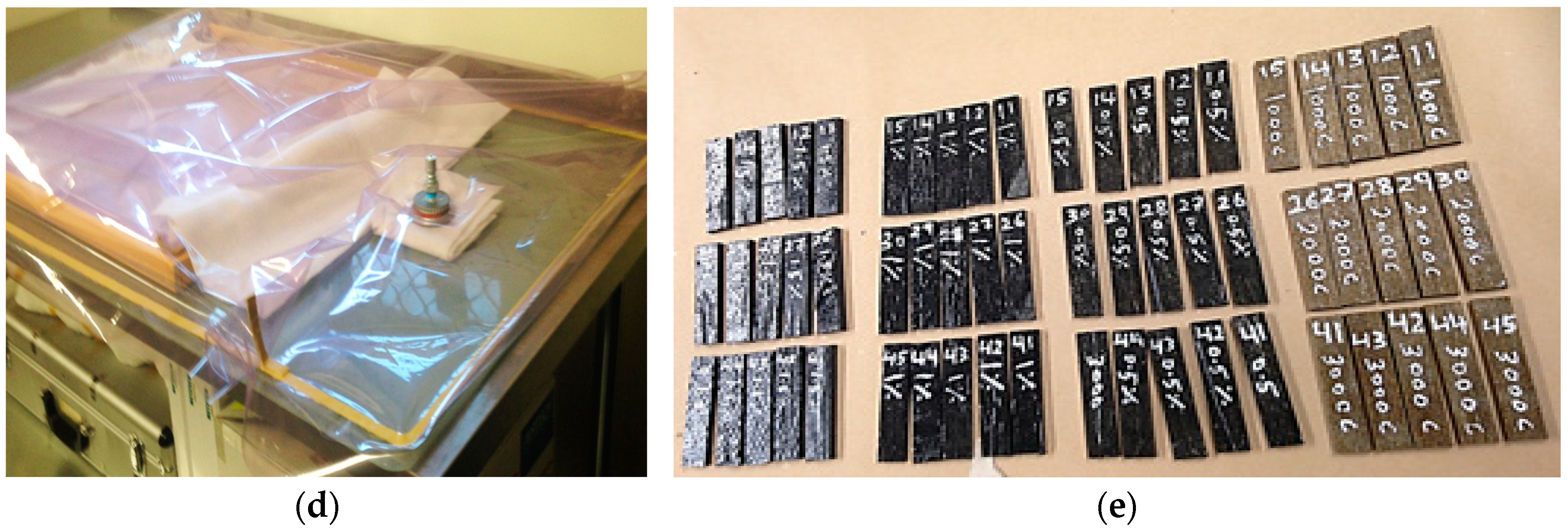
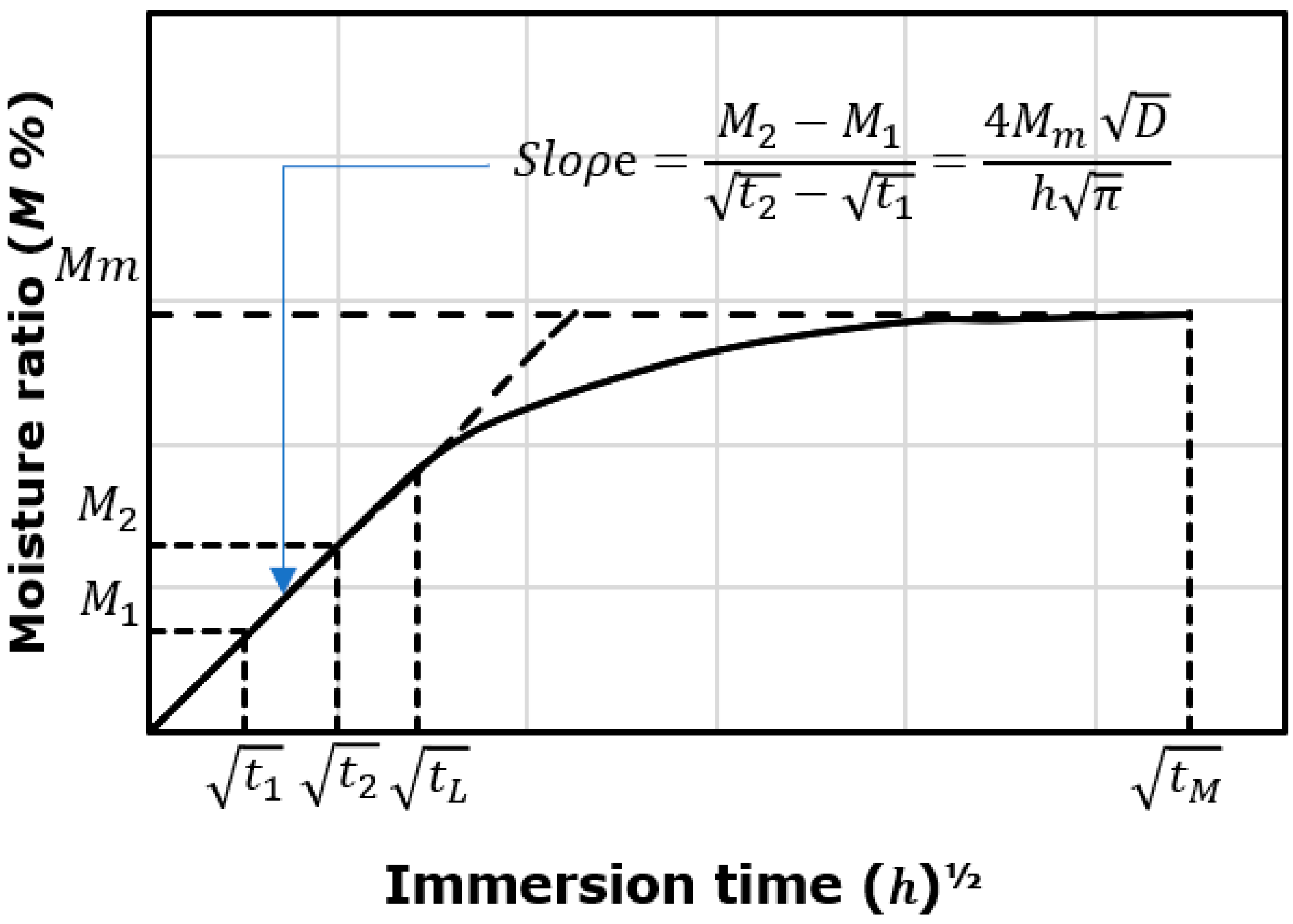


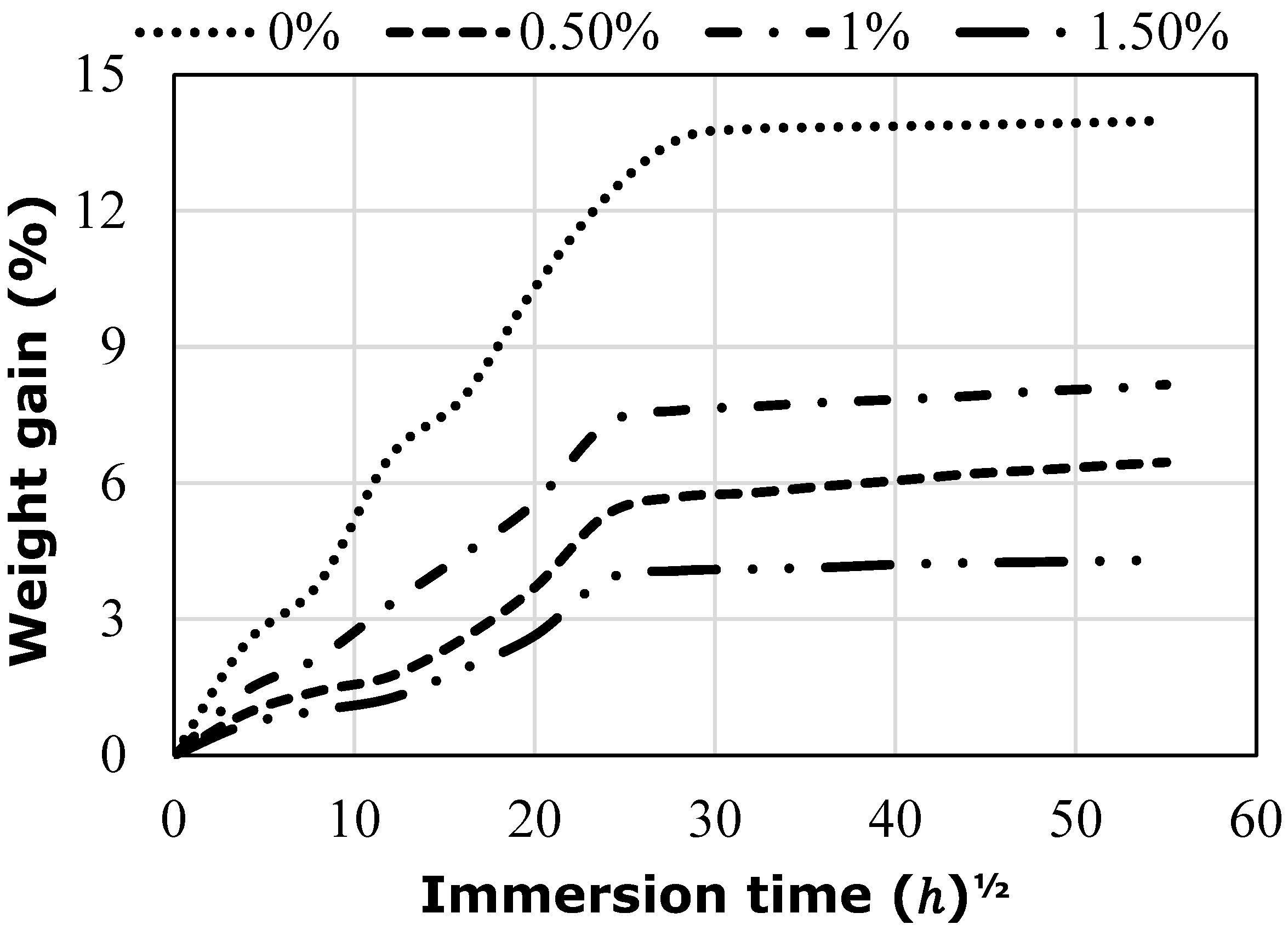
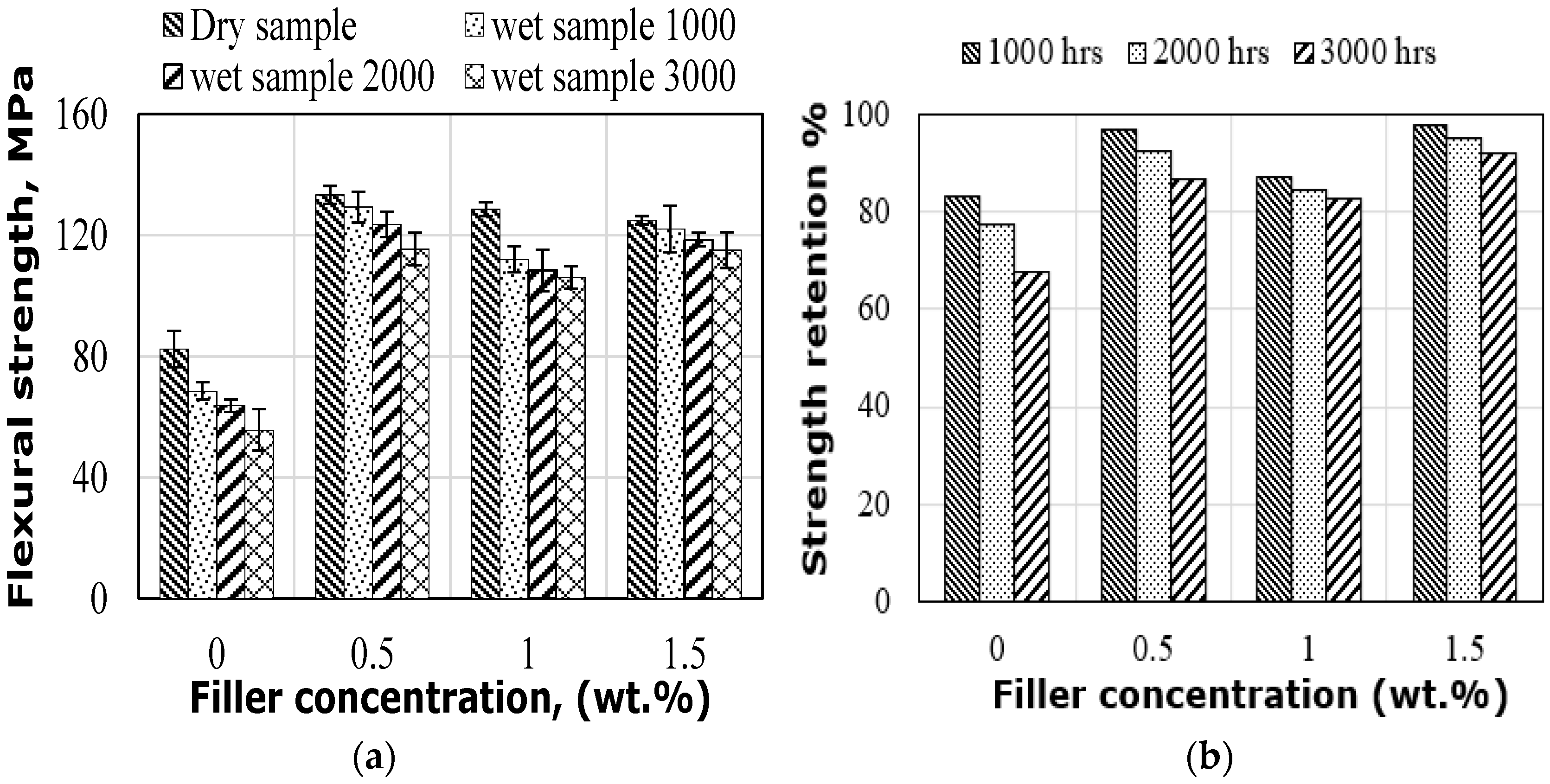



| Cellulose | Hemi-Cellulose | Pectin | Lignin | Wax | Moisture Ratio |
|---|---|---|---|---|---|
| 62–72% | 18.6–20.6% | 2.3% | 2–5% | 1.5–1.7% | 8–12% |
| Material | Density (g/cm3) | Elastic Modulus (GPa) | Tensile Strength (MPa) |
|---|---|---|---|
| Graphene | 0.03 | 340 | 130 × 106 |
| Flax fibres | 1.40 | 70.0 | 1400 |
| Epoxy resin | 1.12–1.17 | 3.4 | 130 |
| Sample | Glass Transition Temperature | ||
|---|---|---|---|
| Dry Condition | Wet Condition | % Drop in Tg | |
| 0% | 72.0 °C | 71.3 °C | 0.97 |
| 0.5% | 76.9 °C | 74.4 °C | 3.25 |
| 1.0% | 79.3 °C | 71.0 °C | 10.47 |
| 1.5% | 80.3 °C | 71.6 °C | 10.60 |
| Condition | Physical Measure | Composite Materials with Filler Ratios | |||
|---|---|---|---|---|---|
| 0% | 0.5% | 1% | 1.5% | ||
| Immersion for 1000 h | Mt% | 13.4 | 4.2 | 6.6 | 3.6 |
| D | 4.8 | 2.8 | 3.5 | 1.4 | |
| Immersion for 2000 h | Mt% | 13.6 | 4.4 | 6.8 | 3.8 |
| D | 4.9 | 3.6 | 4.2 | 2.5 | |
| Immersion for 3000 h | Mt% | 13.7 | 4.6 | 7.0 | 4.0 |
| D | 6.0 | 4.5 | 5.4 | 4.4 | |
Publisher’s Note: MDPI stays neutral with regard to jurisdictional claims in published maps and institutional affiliations. |
© 2022 by the authors. Licensee MDPI, Basel, Switzerland. This article is an open access article distributed under the terms and conditions of the Creative Commons Attribution (CC BY) license (https://creativecommons.org/licenses/by/4.0/).
Share and Cite
Oun, A.; Manalo, A.; Alajarmeh, O.; Abousnina, R.; Gerdes, A. Long-Term Water Absorption of Hybrid Flax Fibre-Reinforced Epoxy Composites with Graphene and Its Influence on Mechanical Properties. Polymers 2022, 14, 3679. https://doi.org/10.3390/polym14173679
Oun A, Manalo A, Alajarmeh O, Abousnina R, Gerdes A. Long-Term Water Absorption of Hybrid Flax Fibre-Reinforced Epoxy Composites with Graphene and Its Influence on Mechanical Properties. Polymers. 2022; 14(17):3679. https://doi.org/10.3390/polym14173679
Chicago/Turabian StyleOun, Amer, Allan Manalo, Omar Alajarmeh, Rajab Abousnina, and Andreas Gerdes. 2022. "Long-Term Water Absorption of Hybrid Flax Fibre-Reinforced Epoxy Composites with Graphene and Its Influence on Mechanical Properties" Polymers 14, no. 17: 3679. https://doi.org/10.3390/polym14173679
APA StyleOun, A., Manalo, A., Alajarmeh, O., Abousnina, R., & Gerdes, A. (2022). Long-Term Water Absorption of Hybrid Flax Fibre-Reinforced Epoxy Composites with Graphene and Its Influence on Mechanical Properties. Polymers, 14(17), 3679. https://doi.org/10.3390/polym14173679










